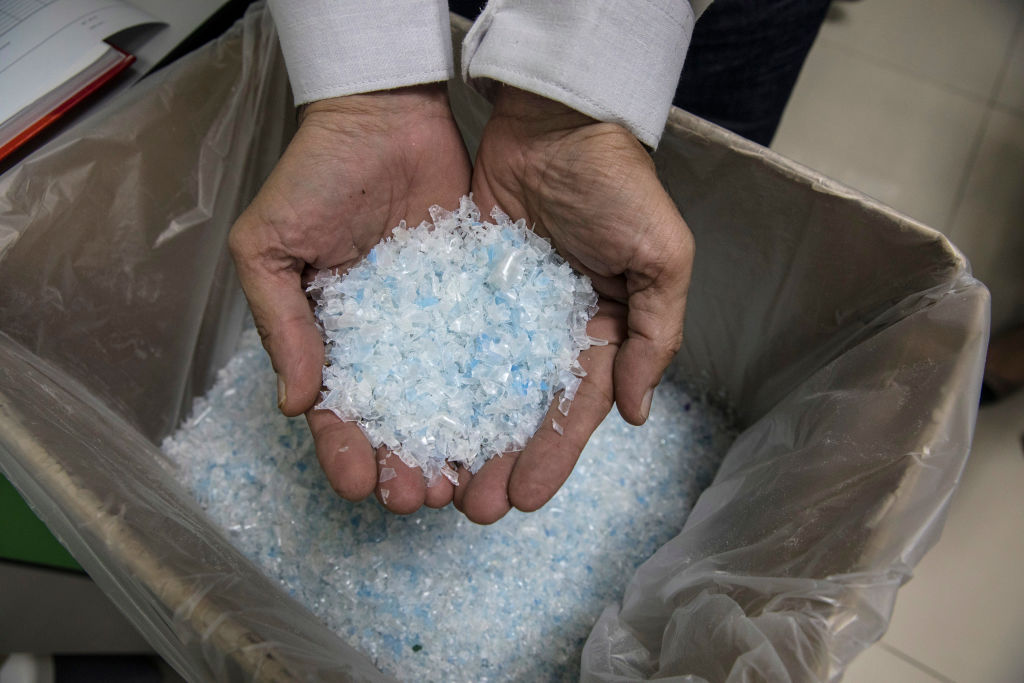4. Strapping: Used to produce high-strength PET strapping bands.
|
|
PET flakes are produced from waste PET bottles through processes such as sorting, washing, crushing, separation, and drying. The quality of the final product directly determines the performance of downstream recycled products, so understanding the various factors that affect the quality of PET flakes is crucial. |
Definition and Applications of PET Flakes
PET flakes refer to small, chip-like recycled plastic materials obtained by processing discarded PET bottles through sorting, crushing, washing, and drying.
Unlike PET pellets, flakes are used either for further processing into pellets or for direct extrusion molding. Pellets (Pellets/Granules) are uniformly sized cylindrical or strip-shaped granules formed by further melting, extruding, and pelletizing the flakes.
Main Applications:
1. Textile Industry: This is the largest application area for recycled PET. The flakes are melted and spun into recycled polyester fiber (rPET Staple Fiber), which is used to produce clothing, carpets, fillings (such as for pillows and down jackets), and non-woven fabrics.
2 . Packaging Industry:
Bottle-to-Bottle: The highest-grade transparent flakes can be reused to produce new PET bottles, especially for beverages, enabling true closed-loop recycling.
Sheets and Containers: Used for producing food trays, clear packaging boxes (such as strawberry containers), blister packs, etc.
3. Construction Industry: Used to manufacture geotextiles, waterproof materials, insulation materials, and more.
Impact of PET Flake Quality on Final Products
The presence of non-polymer contaminants such as PVC or paper can cause uneven coloration, yellow edges, reduced transparency, and clogging during the melting process. In severe cases, they significantly reduce the physical strength of the final product.
Residual moisture leads to hydrolysis during heating and melting, breaking PET molecular chains. This results in decreased melt viscosity (IV value), and negatively affects the gloss and toughness of the finished product.
The inclusion of mixed-color flakes (e.g., green or brown) contaminates clear material, limiting downstream use to downgraded recycling applications.
Excessive moisture content during high-temperature extrusion causes steam to form and become trapped within the plastic, creating micro-bubbles inside the product, which compromises both transparency and strength.
How to Produce High-Quality PET Flakes
1. Strict Raw Material Sourcing and Sorting
-
Identifying Suitable PET Waste: Prioritize purchasing baled PET bottles that have undergone preliminary sorting. Understanding the supplier’s source and sorting capabilities is crucial.
-
Refined Sorting: Even baled bottle bricks require secondary sorting.
-
Automated Sorting: Use advanced equipment such as Near-Infrared (NIR) sorters to remove non-PET plastics, and color sorters to separate PET bottles by color. Establish manual quality control stations as a supplement.
2. Uniform Size Reduction (Crushing/Grinding)
-
Crush PET bottles into uniformly sized flakes (typically 6–15 mm). High-quality wet crushers simultaneously spray water to aid pre-cleaning and reduce blade temperature, ensuring consistent flake size and minimizing fine particles.
3. Washing and Decontamination
-
Pre-wash and Label Removal: Use mechanical friction (label remover) to eliminate most plastic labels and rinse with cold water to remove surface dirt and sand.
-
Hot Chemical Washing: Cook flakes in high-temperature alkaline solution to saponify and dissolve stubborn oils and adhesives.
-
Friction Washing: Use high-speed rotating blades to scrub off residual contaminants.
-
Rinsing: Multiple rinsing tanks thoroughly flush away remaining chemicals and suspended impurities.
4. Efficient Contaminant Separation
-
Sink-Float Separation: PET (density >1 g/cm³) sinks, while most caps and labels (PP/PE) float. This method effectively removes cap material.
-
Air Classification (Z-Shaped Air Separator): Uses airflow to blow away light particles (labels, film, dust), allowing heavier PET flakes to fall and be collected.
-
Material and Color Sorting: For high-quality requirements, post-wash flakes undergo another round of material and color sorting to remove tiny impurities and off-color flakes.
-
Eddy Current and Metal Detection: Install eddy current separators and metal detectors to eliminate aluminum (e.g., cap rings) and ferrous metals at key stages of the production line.
5. Drying Process
-
Mechanical Dewatering: Centrifugal dewatering machines use high-speed rotation to remove most surface moisture from the flakes.
-
Hot Air Drying: Dehydrated flakes are sent into a hot-air drying system. Proper control of air temperature and duration is essential to reduce moisture content to below 1%, while avoiding clumping or thermal degradation.
6 . Laboratory Analysis

 EN
EN 
 English
English 简体中文
简体中文 Русский
Русский España
España عرب .
عرب .
